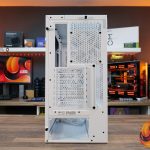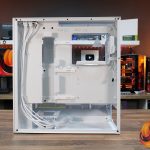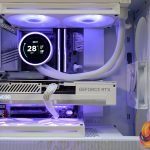
The NZXT H5 Flow has been around for a few years but NZXT has decided that it's time for a refresh, so now there is a new H5 Flow with enhanced airflow and GPU cooling from a redesigned floor, power supply shroud and side panels to provide increased airflow throughout the case and specifically targeting the graphics card. So does this mean the new H5 Flow is better than the old one? Let's find out.
Timestamps:
00:00 Introduction
00:40 The Case Versions / Pricing
01:11 Up close / I/O Panel
03:20 Panels, inside, hardware support
06:08 Back of case
06:27 Right side / floor
08:55 Accessories / test system
10:22 Thermal performance
12:18 Installation process and closing thoughts
NZXT H5 Flow (2024) Features:
- The H5 Flow features enhanced airflow and GPU cooling via the power supply shroud which is perforated on the top and side to enable air intake from two 120mm fans.
- To increase airflow throughout the case the H5 Flow has ultra-fine mesh front, top and side vented panels.
- It supports up to 360mm radiators in the front and up to 240mm at the top (280mm with low-profile RAM), as well as up to eight 120mm fan mounts.
- H5 Flow comes with two NZXT 120mm F120Q quiet airflow fans, one pre-installed in the front and one in the rear for instant out-of-the-box cooling performance.
- Cables can be routed effortlessly in the right-hand side via wide channels and held in neatly using the included hooks and Velcro straps.
Specifications:
- Case Type: Mid-Tower
- Dimensions (LxWxH): 430 x 225 x 465mm
- Net Weight: 28kg
- Material: SGCC Steel, Tempered Glass
- Motherboard Support: E-ATX (Up to 277 mm wide), ATX, Micro-ATX, Mini-ITX
- Expansion Slots: 7
- Storage bays: 2 x 2.5”, 1 x 3.5”
- Max GPU Length: 410mm
- MAX GPU Height: N/A
- MAX GPU Thickness: N/A
- Max CPU Cooler Height: 170mm
- Max PSU Size: ATX up to 200mm
- Pre-installed fans: 2 x 120mm F120Q
- Fan Support: 2 x 120 mm / 2 x 140 mm (Top) 3 x 120 mm / 2 x 140 mm ( Front) 1 x 120 mm (Rear) 2 x 120 mm (Bottom)
- Radiator Support: Up to 240 mm (280mm with low-profile memory only) (Top) up to 360mm (Front)
- Dust Filters: N/A
- Font I/O: 1 x USB 3.2 Type-A, 1 x USB 3.2 Gen2x2 Type-C (20Gbps), 1 x 3.5mm Audio Jack, power button
- LCD Screen: N/A
Thermal Performance Testing
To simulate thermal demand we run the Cinebench R23 multi-thread benchmark and 3DMark Speed Way stress test simultaneously in a loop for 30 minutes to load the system fully. This gives the CPU and GPU enough time to reach constant steady-state temperature. With this data, we can compare how the system handles the thermal demand and measure peak noise levels.
Thermal performance is measured with the case in various configurations, such as the default, with the tempered glass left-hand side panel removed and with the front panel removed to see how these configurations affect the CPU and GPU temperature. During testing, only stock case fans are used unless otherwise specified. All water pumps are set to maximum RPM and fans are set to a custom RPM curve by the Motherboard software/BIOS.
All temperature measurements are presented as Deltas – meaning the ambient temperature has been deducted from the CPU temperature giving us a Delta. Data shown in the charts represent the average component temperature over the length of the test as measured by HWiNFO and then the last 15 minutes of the data are calculated to get the average. The ambient temperature during thermal tests is between 19-20⁰C.
Test System Specification:
- CPU – Intel Core i7-14700K
- Motherboard – Z790 Aorus Elite AX ICE
- Graphics Card – INNO3D RTX 4080 Super X3OC
- Memory – 64GB GSKILL Ripjaws M5 RGB DDR5-6400
- Storage – 1TB Corsair MP700 PCIE Gen5 NVME M.2 SSD
- CPU Cooler – NZXT Kraken Elite 280 (2024)
- Power Supply – NZXT C1000 Gold
- Case fans – Stock + NZXT F240 RGB Core
- Chassis – NZXT H5 Flow 2024
- Operating System – Windows 11
Thermal Performance Overview
We tested the case thermals with a 280mm AIO CPU cooler installed in the roof and with the case in several different configurations. The default configuration shown in the charts is with 1 x 120mm front intake fan, 1 x 120mm rear exhaust fan and no PSU shroud fans.
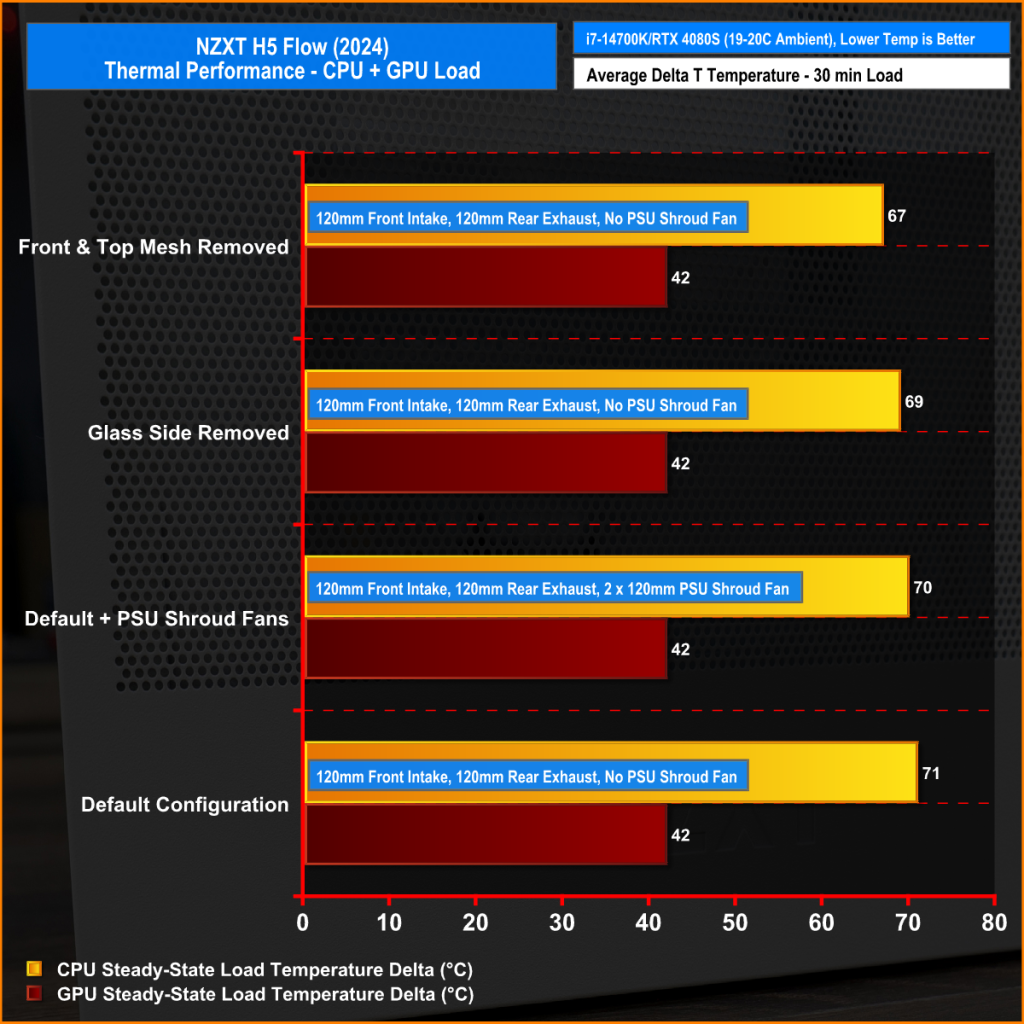
In the default configuration with just the pre-installed 120mm fans, the H5 Flow adequately cools both the CPU and GPU. In fact it does such a good job of cooling the 4080 Super that the graphics card fans barely had to ramp up to keep the GPU core at optimal temperature, so the system ran very quiet during all tests.
Changing the configuration from the default by removing panels had a very small effect on CPU temperature. The most noticeable CPU temperature drop is when the front and top mesh is removed as this completely removes the airflow restriction to the intake and AIO exhaust, still the CPU temperature only drops by 4°C max, so it's not a huge gain.
Adding two 120mm intake fans running at 1000 rpm to the PSU shroud produced a minor drop in GPU temperature but only 2°C so compared with the default configuration it may not be worth the extra cost of adding more fans. However, the mesh power supply shroud is useful as the GPU can draw in cool air from here using its built-in fans so the mesh shroud is a worthwhile feature to have in the case.
Overall the thermal performance is impressive, especially considering this is a hot CPU pulling around 250W package power in a compact chassis.
Closing Thoughts
For a compact relatively cheap ATX mid-tower case the 2024 NZXT H5 Flow has almost everything you would need to house a basic but high-spec gaming system. It supports high-end hardware such as up to EATX form factor motherboards, big graphics cards and radiators up to 360mm long, albeit only in the front panel which isn’t my optimal choice of position for a gaming PC. However, 280mm AIO radiators can be installed in the roof and for most gaming CPUs this is enough cooling power.
The only slight drawback is the space at the top of the case, with a 280mm AIO installed up there it's difficult (or impossible) to connect cables to the motherboard so don’t forget to plug in EPS and fans before installing a 280mm radiator. This space invasion issue would have been much improved if NZXT had made the top radiator mount removable from the chassis which is a feature I like to see in all cases these days.
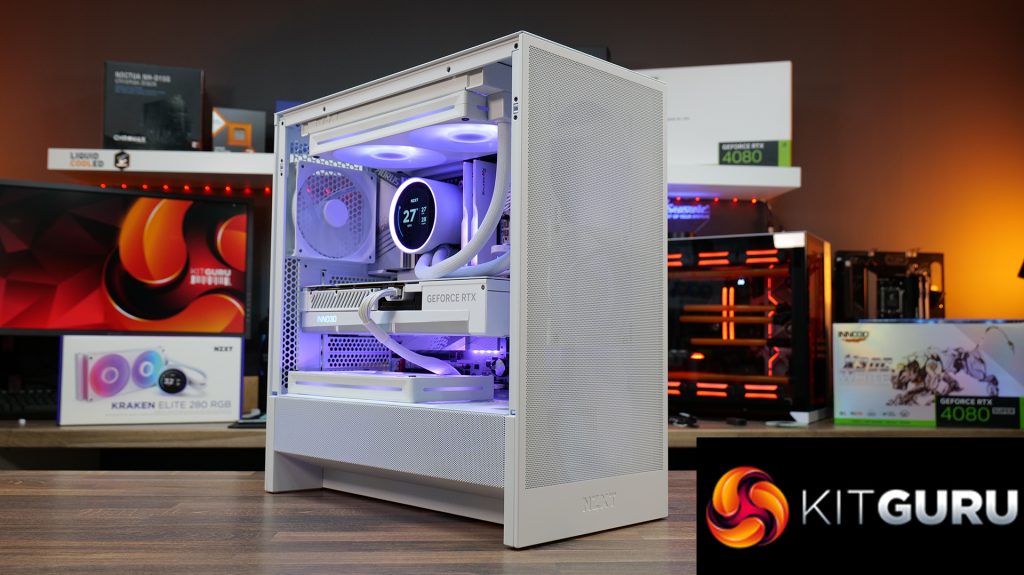
The cable cover at the side of the motherboard is OK at hiding cables but it means you need to have a very tight angle on your 24-pin cable as it comes through from the power supply side, so cables with tough shrinkwrap near the 24-pin connector can be awkward to bend into position. Other than that, the missing grommets from cable cutouts and the fact that you have to run the power supply with the fan up which could cause an airflow conflict with 120mm PSU shroud fans installed, there’s not much to complain about with the H5 Flow.
Build quality is good for a case in this price range, the fans that come with it seem to be reasonably quiet, hardware support is good, cooling works well and the understated looks mean it should fit in well in almost any environment. However, I think NZXT has gone a little too far with the minimalist style when it comes to front panel connectivity, only a single USB Type-A port along with the Type-C is very stingy, you would get away with it on an ITX case but not on a mid-tower, we want at least two Type-A ports here. But even with the sparse front panel, it’s a case I recommend buying if you are looking for a cheap but reliable box for your new gaming PC.
The NZXT H5 Flow (2024) can be purchased now from Scan priced at £89.99 for the standard version HERE or £109.99 for the RGB version HERE.
Pros:
- Compact but good hardware support.
- Excellent cable management.
- Plenty of space under the PSU shroud to connect cables.
- Competitively priced.
- Great thermal performance.
Cons:
- Only one USB Type-A on the front panel.
- No top removable fan bracket.
- No grommets in cable cutouts.
- No Back connect motherboard support.
KitGuru says: If you are looking for a budget but cool box for your new gaming PC and you want functional but minimalist looks, the 2024 NZXT H5 Flow could be the one for you.
 KitGuru KitGuru.net – Tech News | Hardware News | Hardware Reviews | IOS | Mobile | Gaming | Graphics Cards
KitGuru KitGuru.net – Tech News | Hardware News | Hardware Reviews | IOS | Mobile | Gaming | Graphics Cards





